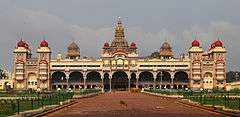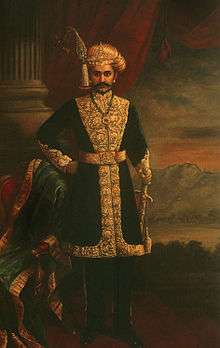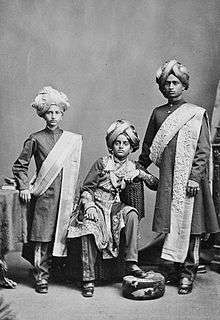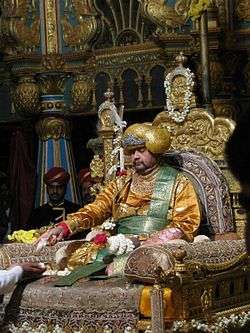Wadiyar dynasty
The Wadiyar (alternatively spelt Wodeyer or Odeyer) dynasty was an Indian Hindu dynasty that ruled the Kingdom of Mysore from 1399 to 1761 and from 1799 to 1947. The kingdom was incorporated into the Dominion of India after its independence from British rule.







Name
In Kannada, the word "Wadiyar" (ಒಡೆಯರ್) means "Lord" or "Lordship." Historical records use the term ″Wodeyar″ when referencing the dynasty's royal family members; the ″W″ is silent. In more modern Kannada transliteration, the variation ″Odeyar″ is also used.
History
The origin of Wodeyars is traced to Yadavas of Dvārakā in Gujarat, who came to Karnataka and seeing beauty of the place made Mysore their abode.[1] The Yadavas then ruled over the area for 600 years.[2] The dynasty was established in 1399 by Yaduraya Wodeyar. He ruled Mysore under the Vijayanagara Empire until 1423. After Yaduraya Wodeyar, the Mysore kingdom was succeeded by the Wadiyar rulers. The kingdom remained fairly small during this early period and was a part of the Vijayanagara Empire. After the fall of the Vijayanagara Empire in 1565, the Kingdom of Mysore became independent and remained so until 1799.
During the reign of Krishnaraja Wadiyar III (1799–1868), the region came under the control of the British Empire. His successors changed the English spelling of their royal name to Wadiyar and took the title of Bahadur. The last two monarchs of the dynasty, Krishnaraja Wadiyar IV and Jayachamarajendra Wadiyar, also accepted the British decoration Knight Grand Cross of The Most Excellent Order of the British Empire (GBE).
Expansion
The Vijayanagara Empire disintegrated in 1565. The power vacuum created soon after was exploited by Raja Wadiyar (ruled 1578–1617). He expanded the borders of the Mysore kingdom and in 1610 changed the capital city from Mysore to Srirangapatna; a rare island formed by the river Kaveri, which provided natural protection against military attacks.
Later famous rulers of the dynasty included Kanthirava Narasaraja I (ruled 1638–1659), who expanded the frontiers of the Mysore kingdom to Trichy in Tamil Nadu. The dynasty reached its peak under Chikka Devaraja (ruled 1673–1704), who reformed the administration of the empire by dividing it into 18 departments (called Chavadis) and he also introduced a coherent system of taxation.
From 1760 to 1799, the rule of the dynasty was essentially nominal, with real power in the hands of the dalwai, or commanders-in-chief, Hyder Ali and his son Tipu Sultan, who expanded the kingdom aggressively, but clashed with the British East India Company. After Tipu Sultan was killed by the British in the Battle of Srirangapatna in 1799, the Wadiyars were restored to a reduced kingdom.
British Rule

After restoring the Wadiyars to the throne of Mysore, the British shifted the capital back to the city of Mysore from Srirangapatna. The four-year-old boy (Mummudi) Krishna Raja Wadiyar III, son of the last Wadiyar king, Khasa Chamaraja Wadiyar VIII, was anointed as the King of Mysore. Wadiyars were now subsidiaries of the British Raj and had to pay an annual subsidy to the British. However the British took over the administration of the kingdom on a specious plea of non-payment of the subsidy by Mummudi Krishna Raja Wadiyar in 1831, and British-appointed commissioners were then in charge of the kingdom.
British commissioners administered Mysore from 1831–1881. Mark Cubbon (1834–1861) and L. B. Bowring (1861–1870) are among the well-known commissioners of the period.
In 1868, the British Parliament heeded the king's plea and decided to restore the kingdom to his adopted son Chamaraja Wadiyar IX. In 1881, the transfer of power back to the Wadiyars heralded an important phase in the making of modern Mysore. For the first time in India, democratic experiments were introduced by the establishment of a representative assembly. The next king, Nalvadi Krishna Raja Wadiyar, earned great fame as a saintly King-Rajarishi, and his kingdom was hailed as Ramarajya by Mahatma Gandhi as an ideal kingdom comparable to the one ruled by the historical hero Lord Rama.
Under British hegemony, the Wadiyars, freed from security concerns, shifted their attention to the patronage of the fine arts. They made Mysore a cultural center of Karnataka, fostering a number of famous musicians, writers and painters.
The last king of the Wadiyar dynasty was Jayachamarajendra Wadiyar, who ruled from 1940 until Indian independence from British rule. In the year 1947, after India attained independence, he ceded his kingdom to the Dominion of India, but continued as the Maharajah until India became a Republic in 1950. He became the Raja Pramukh—a constitutional position—as the head of Mysore State in the Republic of India from 1950–1956. After the reorganization of the Indian states on a linguistic basis, he was appointed Governor of the integrated Mysore State (present Karnataka State) in 1956 and held the post until 1964.
Then he was Governor of Madras state (now Tamil Nadu) for two years. The Indian Constitution continued to recognize him as the Maharajah of Mysore, until 1971, when Mrs. Indira Gandhi, then Prime Minister of India, abolished the titles and Privy Purse of over 560 Maharajahs. The Maharajah died in 1974. His only son, Srikanta Datta Narasimha Raja Wadiyar (1953–2013), was a member of the Indian Parliament for many years.
Wadiyar Rulers of Mysore
- Yaduraya (1399–1423)
- Hiriya Bettada Chamaraja Wadiyar I (1423–1459)
- Thimmaraja Wadiyar I (1459–1478)
- Hiriya Chamaraja Wadiyar II (1478–1513)
- Hiriya Bettada Chamaraja III Wadiyar (1513–1553)
- Thimmaraja Wadiyar II (1553–1572)
- Bola Chamaraja Wadiyar IV (1572–1576)
- Bettada Chamaraja Wadiyar V(1576–1578)[3]
- Raja Wadiyar I (1578–1617)
- Chamaraja Wadiyar VI (1617–1637).
- Raja Wadiyar II (1637–1638)
- (Ranadhira Kantheerava) Narasaraja Wadiyar I (1638–1659)
- Dodda Devaraja Wadiyar (1659–1673)
- Chikka Devaraja Wadiyar (1673–1704)
- Narasaraja Wodeyar II (1704–1714)
- Dodda Krishnaraja Wodeyar I (1714–1732)
- Chamaraja Wadiyar VII (1732–1734)
- (Immadi) Krishnaraja Wadiyar II (1734–1766)
- Nanajaraja Wadiyar (1766–1770)
- Bettada Chamaraja Wadiyar VIII (1770–1776)
- Khasa Chamaraja Wadiyar IX (1766–1796)
- Krishnaraja Wadiyar III (1799–1868)
- Chamarajendra Wadiyar X (1868–1894)
- Vani Vilas Sannidhana, queen of Chamarajendra Wadiyar X, was Regent from 1894–1902.
- Krishnaraja Wadiyar IV (1895–1940)
- Jayachamarajendra Wadiyar (1940–1950) [4]
- Rajpramukh of Mysore state (1950–1956)
- Governor of Mysore state (present-day Karnataka) (1956–1964)
- Governor of Madras State (present-day Tamil Nadu) (1964–1966)
- De-recognized as Maharajah of Mysore by the 26th Amendment to the constitution in 1971.
- Died on 23-9-1974.
- Prince Srikantadatta Narasimharaja Wadiyar (1974–2013; ascended the throne in 1974; died on 10 December 2013)
- Yaduveer Krishnadatta Chamaraja Wadiyar (2015–present; ascended the throne on May 28, 2015[5])
Curse on Wadiyars
A curse has believed to be casted on the Wadiyar in 1612 by Alamelamma, wife of King Tirumalaraja, who ruled the Vijayanagar Empire . It is believe when her jewels were being taken under the orders of the Wodeyar ruler, she ran over to a cliff overlooking the Kaveri river, curse before jumping to death. “Talakadu Maralagi, Malangi Maduvagali, Mysooru Arasarige Makkalaagadirali” (May Talakadu become a baren land, Malangi turn into a whirlpool and may Mysore kings never beget children). 400 since, the Wadiyar dynasty never had any children alternate generation. Hence the adopted child becomes the king .Even till date ,most parts of Talakadu (Talakad lies under sand, and Malangi village in present Mysore district is getting slowly eroded due to whirlpools.[6][7][8]
The Mysore kingdom, founded by Yaduraya in the year 1399, consisted of only the areas surrounding the present Mysore City. In fact, the original fort was supposed to have been at a place known as haDadana — now a small village on the southern side of Chamundi Hill. The Wadiyars, like all others at that time, were under the suzerainty of the Vijayanagar Empire. The Viceroy of the Vijayanagar kingdom was headquartered at Srirangapatna. Under Yaduraya, the Wadiyars increased their influence and territory over the next 200 years. Raja Wadiyar, the ninth ruler of the dynasty, was known for his valor and patronage of art and culture. He ruled from 1578 to 1617. In 1610, he conquered the fort of Srirangapatna from Tirumala, then Viceroy of Vijayanagar. Tirumala is said to have retired to Talakad along with his two wives. One of them, Alamelamma, was a staunch devotee of Sri Ranganayaki, the consort of Sri Ranganatha, the presiding deity of the famous Adi-Ranga temple in the island fortress of Srirangapatna.
Tirumala suffered from a deadly disease on his back known as the "disease of the kings". The condition of Tirumala deteriorated and he died. Alamelamma had a large amount of precious jewelry, including a fine nose ring studded with a large pearl. As a widow she was no longer permitted the use of jewellery. So she donated the jewels to the temple of Sri Ranganayaki. Every Friday and Tuesday Sri Ranaganayaki was decorated with a large pearl-studded nose ring and other precious jewellery, which was put into the safe custody of Alamelamma the rest of the week, since she was known to be a staunch devotee of Sri Ranganayaki. The temple authorities requested Raja Wadiyar to give them the custody of the jewels, as was the normal practice. The treasury officials informed the king of these facta. Raja Wadiyar thought these jewels were of no value to Alamelamma, as she was now a widow and no longer needed them. Raja Wadiyar sent emissaries to Malangi, where Alamelamma was staying, with a request to return the jewels. Only the pearl-studded nose ring was returned by Alamelamma. Raja Wadiyar then sent his army to Talakad to ask her once again and if she refused, to seize them by force. To escape the wrath of the Mysore army, Alamelamma uttered the legendary curse on Raja Wadiyar and jumped into a whirlpool in the river Kaveri at Talakadu with the rest of the jewels, but escaped unscathed. The curse, as passed down in folklore over the last 400 years is:
| “ | ತಲಕಾಡು ಮರಳಾಗಲಿ, ಮಾಲಂಗಿ ಮಡುವಾಗಲಿ, ಮೈಸೂರು ದೊರೆಗಳಿಗೆ ಮಕ್ಕಳಿಲ್ಲದೆ ಹೋಗಲಿ | ” |
| “ | Talakadu maralagali, Malangi maduvagali, Mysuru doregalige makkalilllade hogali | ” |
| “ | May Talakad turn into (a barren expanse of) sand, May Malangi turn into a whirlpool, May the Rajas of Mysore not have children (for all time to come). | ” |
Hearing of this extreme step taken by Alamelamma, Raja Wadiyar was truly repentant. He wanted to return the jewelry to the temple and not confiscate it for his own use. In his grief he had an idol of Alamelamma made in gold, installed it in the palace, and worshipped it as a deity. A remnant of her hair was also preserved in a box. Even to this day Alamelamma’s idol can be found inside the Mysore Palace and is worshiped by the Royal Family. One can see the same huge pearl nose-stud adorning both the Goddess Ranganayaki and Alamelamma today. The Dasara Festivities inside the palace end on the evening of Navarathri with a formal pooja to Alamelamma, and the Kankana worn by the Royal Couple is removed there after paving the way for the Vijaya Dashami – Sami pooja the next day. For these nine days the Royal Couple are required to stay inside the precincts of the palace. Another very interesting part of the story is that this Alamelamma Temple is under the care of the legal heirs of Alamelamma, and they still live inside the Mysore Palace fort. Strangely, even these priests/caretakers appear to be cursed, and they do not beget children and follow the same pattern afflicting the Wodeyars!
The Curse from the Time of Raja Wadiyar
After shifting to Srirangapatna, Raja Wadiyar is credited with holding the famous Dasara Festivities for the first time in 1610. His only surviving son, Narasraja Wadiyar, died (an effect of the curse!) just a day before the commencement of Navaratri, but the king after consulting experts laid down the rule that the celebration of the ceremonies was not to be interrupted even by the death of members of the royal family. Raja Wadiyar was a devotee of Vaishnavaite, and he donated the famous bejewelled crown to the Lord Cheluvarayasvami of Melkote that is a feature of the Raja Mudi car festival even today. This is in contrary to his own lineage as the Wadiyars regarded the temple of Karigiri Lakshmi Narasimha (Devarayana Durga, Tumkur) as their household deity. The mere fact that all the Wadiyars end their names by "-Narasimharaja Wadiyar" stands testimony to what was previously stated. This crown was confiscated from the royal Family by the Karnataka Government during an emergency! Legend has it that Raja Wadiyar, having entered the garbha–griha (sanctum sanctorum) of Cheluvarayasvami Temple on June 20, 1617, became one with the deity (aikya). Even today one can find a Bhakthi Vigraha of the King inside the Temple. Another Bhakthi Vigraha of the King can be found inside the Lakshmi-Narayanasvami Temple inside the Mysore Palace Fort. Malangi and Talakad are two small towns near Tirumakudalu Narasipura on the banks of the Kaveri where the river takes a bend. Talakad's temples lie buried in the vast expanse of sand and are dug up and exposed every 12 years. At Malangi, on the other hand, the river is at its deepest. Whether these phenomena appeared only after Alamelamma's curse in 1610 is a matter of conjecture. What can be stated with certainty is that the curse on the royal family seems to have come true.
From Raja Wadiyar’s death in 1617 to that of Chikka Devaraja Wodeyar in 1704 (there were four rulers in between) the kingdom was ruled by the surviving descendants of Yaduraya, but none could beget legal heirs! Incidentally, Chikka Devaraja Wodeyar is credited with the composition of Gita Gopala – an opera in Kannada. The sole exception to the curse was Chikka Devaraja's deaf and mute son Kantheerava Narasaraja Wodeyar II, also known as Mookarasu. He was succeeded by his son Dodda Krishna Raja Wodeyar, who ruled from 1714 to 1732. With him Yaduraya’s direct lineage came to an end. What followed was a succession of nominal rulers adopted by the surviving queens to continue the tradition. Traditional army commanders known as Dalvoys virtually ruled the kingdom and paved the way for the ascendancy of a foot soldier like Hyder Ali by 1762. There were five rulers from 1732 to 1796. In this period a definite pattern emerged under which no natural heir to the throne born to a king (adopted or otherwise) could beget children, whereas one who became king by virtue of adoption or other indirect inheritance was blessed with a legal heir. Hyder and Tipu continued the tradition of having a nominal Wodeyar King on the throne, and even the Dasara Celebrations continued as usual. After the famous Fourth Anglo-Mysore War and the death of Tipu Sultan, a British army, in which the legendary Arthur Wellesley (later Duke of Wellington, also known as the Iron Duke) was serving, conquered Srirangapatna in 1799.
See also
- Kingdom of Mysore
- Mysore State
- Hyderabad State
- Baroda State
- Gwalior State
- Karnataka
- Mysore
- Talakad
- Srirangapatna
- C. Hayavadana Rao
Notes
- ↑ H S Gururaja Rao (2014). My Life, My Profession. Lulu Press, Inc. ISBN 9781483410654.
- ↑ Vikram Sampath. SPLENDOURS OF ROYAL MYSORE (PB). Rupa Publications. pp. Introd. I. ISBN 9788129115355.
- ↑ According to the Court Historian and Chief Editor of the Mysore Gazetteer, Mr C. Hayavadana Rao, this ruler's name was Bettada Devaraja Wadiyar. But since the Annals of Mysore Royal Family, a book published by the Royal House, sticks to this version, it is adopted here as authentic<
- ↑ Anwar Haroon (29 June 2013). Kingdom of Hyder Ali and Tipu Sultan. Xlibris Corporation. p. 24. ISBN 978-1-4836-1536-3.
- ↑ In Yaduveer, erstwhile Mysuru kingdom gets new king
- ↑ Vanu Dev (December 11, 2013). "Four hundred-year-old 'curse' returns to haunt Wadiyar royals with death of last heir". Daily Mail. Retrieved 2015-10-11.
- ↑ "Does Alamelamma's curse continue to haunt Wadiyars?". Deccan Herald. December 10, 2013. Retrieved 2015-10-11.
- ↑ "400-year-old curse haunts Wodeyar royals of erstwhile princely state of Mysore". India Today. December 12, 2013. Retrieved 2015-10-11.
External links
| Wikimedia Commons has media related to Wadiyar dynasty. |
- The Wodeyars of Mysore (1578 A.D. to 1947 A.D.)
- History of Mysore Wodeyars
- Mysore – Imperial City of Karnataka
- Genealogy of the Wodeyar Dynasty
- Curse on Wodeyars: Documenting a Legend
- [http://www.hindu.com/lr/2006/02/05/stories/2006020500150300.htm] Curse on Wodeyars: ORAL TRADITIONS -Legend and history]
- Coins of the Wodeyars
- Sri Kanteerava Narasimharaja Wadiyar
- The Wodeyar / Wadiyar Dynasty (Official Website of Mysore Palace)Mysore topics
Kings Religious Palaces Art and Culture Cuisine Museums and Institutions Personalities Places
